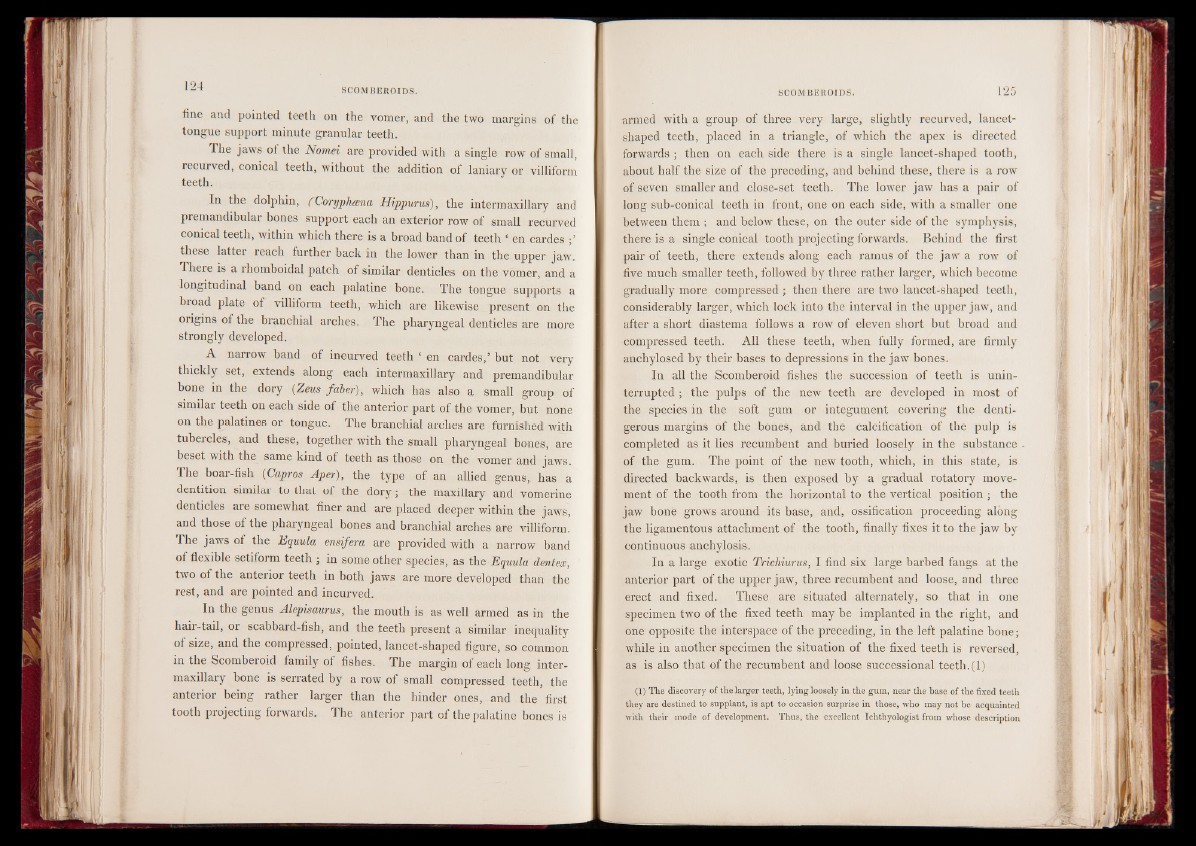
fine and pointed teeth on the vomer, and the two margins of the
tongue support minute granular teeth.
The jaws of the Nomei are provided with a single row of small,
recurved, conical teeth, without the addition of laniarv or villiform
teeth.
In the dolphin, ('Coryphama Hippurus), the intermaxillary and
premandibular bones support each an exterior row of small recurved
conical teeth, within which there is a broad band of teeth ‘ en cardes
these latter reach further back in the lower than in the upper jaw.
There is a rhomboidal patch of similar denticles on the vomer, and a
longitudinal band on each palatine hone. The tongue supports a
broad plate of villiform teeth, which are likewise present on the
origins of the branchial arches. The pharyngeal denticles are more
strongly developed.
A narrow hand of ineurved teeth ‘ en cardes,’ but not very
thickly set, extends along each intermaxillary and premandibular
bone in the dory (Zeus faber), which has also a small group of
similar teeth on each side of the anterior part of the vomer, but none
on the palatines or tongue. The branchial arches are furnished with
tubercles, and these, together with the small pharyngeal bones, are
beset with the same kind of teeth as those on the vomer and jaws.
The hoar-fish (Capros Aper), the type of an allied genus, has a
dentition similar to that of the dory; the maxillary and vomerine
denticles are somewhat finer and are placed deeper within the jaws,
and those of the pharyngeal bones and branchial arches are villiform.'
The jaws of the Equula ensifera are provided with a narrow hand
of flexible setiform teeth ; in some other species, as the Equula dentex,
two of the anterior teeth in both jaws are more developed than the
rest, and are pointed and incurved.
In the genus Alepisaurus, the mouth is as well armed as in the
hair-tail, or scabbard-fish, and the teeth present a similar inequality
of size, and the compressed, pointed, lancet-shaped figure, so common
in the Scomberoid family of fishes. The margin of each long intermaxillary
hone is serrated by a row of small compressed teeth, the
anterior being rather larger than the hinder ones^ and the first
tooth projecting forwards. The anterior part of the palatine bones is
armed with a group of three very large, slightly recurved, lancet-
shaped teeth, placed in a triangle, of which the apex is directed
forwards ; then on each side there is a single lancet-shaped tooth,
about half the size of the preceding, and behind these, there is a row
of seven smaller and close-set teeth. The lower jaw has a pair of
long sub-conical teeth in front, one on each side, with a smaller one
between them ; and below these, on the outer side of the symphysis,
there is a single conical tooth projecting forwards. Behind the first
pair of teeth, there extends along each ramus of the jaw a row of
five much smaller teeth, followed by three rather larger, which become
gradually more compressed ; then there are two lancet-shaped teeth,
considerably larger, which lock into the interval in the upper jaw, and
after a short diastema follows a row of eleven short but broad and
compressed teeth. All these teeth, when fully formed, are firmly
anchylosed by their bases to depressions in the jaw bones.
In all the Scomberoid fishes the succession of teeth is uninterrupted
; the pulps of the new teeth are developed in most of
the species in the soft gum or integument covering the dentigerous
margins of the bones, and the calcification of the pulp is
completed as it lies recumbent and buried loosely in the substance
of the gum. The point of the new tooth, which, in this state, is
directed backwards, is then exposed by a gradual rotatory movement
of the tooth from the horizontal to the vertical position ; the
jaw hone grows around its base, and, ossification proceeding along
the ligamentous attachment of the tooth, finally fixes it to the jaw by
continuous anchylosis.
In a large exotic Trichiurus, I find six large barbed fangs at the
anterior part of the upper jaw, three recumbent and loose, and three
erect and fixed. These are situated alternately, so that in one
specimen two of the fixed teeth may be implanted in the right, and
one opposite the interspace of the preceding, in the left palatine hone;
while in another specimen the situation of the fixed teeth is reversed,
as is also that of the recumbent and loose successional teeth. (1)
(1) The discovery of the larger teeth, lying loosely in the gum, near the base of the fixed teeth
they are destined to supplant, is apt to occasion surprise in those, who may not be acquainted
with their mode of development. Thus, the excellent Ichthyologist from whose description